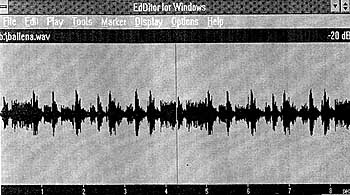
Word of Whale
By Cristina Cioffi
Translated by Guillermo Ramon Gil (FAMDIVER)
MARINE MAMMALS BIOACOUSTICS
IN THE COAST OF ARGENTINA
EXPEDITION 71-3 OF THE INVESTIGATION SHIP HERO


ifferent communication ways exist among
the cetaceans. They combine more or less amounts of chemical, tactile and
visual signs, but acoustic signs are the most broadly used and the ones
with a higher efficiency, even at long distances, through a single channel.
To be able to use that acoustic
communication channel, a species should be able to emit some stimulus in
this channel and to detect those stimuli with a specific mechanism. This way,
we have a communication system.
Konrad Lorenz says: "there is only one
psychology to set comparison systems. To enhance our knowledge about the
human behavior we need, more than ever, to investigate that of the mammals,
especially of those evolved ones. That observation demands enormous
quantities of time and resources, and the results are not immediate.
We must consider about the history of the
species today, we cannot delay the acquisition of that knowledge because it’s
difficult to obtain. All the sciences somehow related to human behavior have
the obligation to accept this new dimension."
That is: there is a narrow relationship
between the human behavior and the behavior of the rest of mammals.
The study of communication evolution in
Mysticeti is in a primitive state so far. This is because of the high
amounts of resources, both of time and money, needed to follow a single
animal in open water.
We could generalize anyway by saying that
the number of fibers of the cochlear portion of a whale’s brain is many
times bigger than that of the man. This amount of fibers is directly related
with the acoustic abilities of the animal, so the whales have outstanding
audition abilities.
These enhanced hearing abilities are
supported by an impressive development of the parietal lobe of the brain and
by a series of modifications in the inner ear that permit underwater
audition.
   
Some pictures of whales shot during this expedition... (clic
to zoom)
INTERESTING DATA
By using a system of calibrated hydrophones,
the expedition 71/3 of the oceanographic vessel Hero registered more than
200 low frequency sounds produced by whales in the San José Gulf, along
several periods.
Most sounds were expressions similar to
burps, with an average duration of 1.4 seconds and with frequencies ranging
from 30 to 2,200 Hz. The original levels of emission were very high and
ranged from 172 to 187 db/m2. Measurements were carried out on a wide
spectrum, from 30 to 2, 200 Hz.

Whales also produced a series of different
sounds, similar to groans, which lasted among 0.6 to 4.1 seconds. The groans
extended up in frequency to 1,250 Hz. As in the burp sounds, groan sounds
had the most energy below the 500Hz frequency.
During the investigations, a curious
phenomenon was evident: “It has been observed that the gulls pick the whales,
which suggests that they feed on the whale’s parasites. This interesting
association should be studied in more depth. Picking gulls are of the
species Larus dominicanus and Larus maculipinnis.
When the ship HERO, in charge of Capt.
William C.Cummings, where James F.Fish, of the
Centro Naval Submarino de Investigación y Desarrollo, detected this
association, they simply couldn’t imagine that a woman -20 years later!-,
would achieve this picture. What a better coordination sample....

In the precise moment that the spiracle of the whale
blows water out, the gull picks her without leaning
her weight on, after a long and patient waiting time.


Some pictures shot in the Gulf of San José
(clic to zoom)

© Text and Pictures:
Cristina Cioffi
© Translation: Guillermo Ramón Gil (FAMDIVER)
The drawing before the title was performed
by a 9 years old girl
after the author explained these experiences in a School of her country.
This article was given
the

|